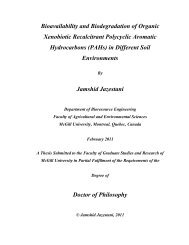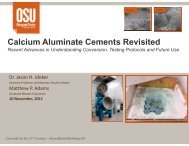i THERMAL PROCESSING EFFECTS ON TOTAL ... - McGill University
i THERMAL PROCESSING EFFECTS ON TOTAL ... - McGill University
i THERMAL PROCESSING EFFECTS ON TOTAL ... - McGill University
Create successful ePaper yourself
Turn your PDF publications into a flip-book with our unique Google optimized e-Paper software.
ehind microwave heating involves oscillatory migration of ions which produces heat in<br />
the food under the influence of an electric field (Brijesh et al., 2011). According to Meda<br />
et al., (2005), microwave heating exploits the dielectric behavior of the substance in such<br />
a manner as to generate heat only up to a certain depth from the surface of the product.<br />
There is an exponential decay of microwave energy as the waves penetrate into the<br />
product from the surface, depending on the dielectric properties of the substance.<br />
Kadlec et al., (2001) found that the sucrose and monosaccharide content of dried<br />
germinated peas was constant, but decreased after MW treatment to 78% and 83% of<br />
original levels, respectively. Stewart and Raghavan, (2003) showed that MW drying<br />
preserved TIA and retained higher quantities of fatty acids, to produce better quality<br />
soybeans [Glycine max (L.) Merr.]. Microwave heating at a power density of 3 W g -1<br />
using a 1:1.5 samples to water ratio retained a maximum amount of vitamin content in<br />
red lentils (Dev et al., 2010). Sharma and Gujaral, (2011) found a decrease in TPC and<br />
antioxidant activity in barley (Hordeum vulgare L.) (after sand roasting and microwave<br />
roasting). The greater loss in TPC may be due to a longer heating time in the microwave<br />
oven.<br />
By applying microwaves processing to pulses such as chickpeas (Cicer arietinum<br />
L.) and common beans (Phaseolus vulgaris L.) (Marconi, et al., 2000) reported changes<br />
in the cooking quality, physiochemical characteristics, along with nutritional<br />
modifications in starch and non-starch polysaccharides. Scanning electron microscopy of<br />
microwave-heated and traditionally processed legumes shows similar effects with respect<br />
to in-vitro starch digestibility. Gonzalez and Perez, (2002) reported that microwave<br />
irradiation and extrusion cooking caused several changes in rheological, functional and<br />
morphological characteristics of lentil starches. Both treatments reduced the retro<br />
gradation tendency of lentil starch for the processing industry, which would be an<br />
interesting for the processing industry, since this is one of the reasons that have limited its<br />
commercial use. The in-vitro protein digestibility of microwave and pressure-cooked<br />
comestible legumes varies significantly, but averages about 75% and 80%, respectively<br />
(Khatoon and Prakash, 2004).<br />
14









